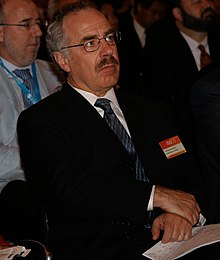Raymond Jeanloz
Raymond Jeanloz (born August 18, 1952 in Winchester (Massachusetts) ) is an American geophysicist .
biography
Jeanloz studied at Deep Spring College (in Deep Spring ), Amherst College (Bachelor 1975) and Caltech , where he received his doctorate in 1979. He was then Assistant Professor at Harvard University from 1979 to 1981 and has been Associate Professor since 1982 and Professor of Astronomy, Planetology and Geophysics (Earth and Planetary Science) at the University of California, Berkeley since 1985 .
Jeanloz deals with the behavior of matter at high pressures, such as those found in the interior of the earth and other planets. He simulates the pressures with diamond anvil cells and dynamically with shock waves from the radiation with high-power lasers, with the aim of simulating conditions inside large planets like Jupiter. He also uses the synchrotron radiation source at the Lawrence Berkeley National Laboratory for material analysis.
Jeanloz played an important role in the development of diamond anvil cell technology in the 1980s, for example through additional continuous heating with lasers (Laser Heated Diamond Anvil Cell). One result of the research was that the material in the earth's mantle at high pressures (over 100,000 atm) mainly consists of perovskites and Jeanloz determined the melting curve of perovskites at high pressures in experiments (for example with Heinz 1987). Further results concerned the character of the transition zone from the liquid metallic earth core to the mantle ( D "layer ).
Together with his doctoral student Kanani Lee, he discovered a new high-pressure alloy of potassium with iron in 2003, which could explain the relatively low potassium concentration in the earth's crust compared to data in stone meteorites and probably radioactive potassium as another source of heat generation in the earth's core alongside uranium and thorium power.
Jeanloz also works on disarmament issues and chairs the National Academy of Sciences Committee on International Security and Arms Control (CISAC). In this context, he examined the management of the US nuclear weapons stocks and concluded in his report that even without the development of new weapons, the stocks would be stable for at least 60 years. For this he received the Hans Bethe Award of the Federation of American Scientists (FAS) in 2008 and was Szilard Lecturer of the American Physical Society in 2009 and became its Fellow. Jeanloz was an advisor to the Department of Energy (DOE) on these and similar questions as early as the 1990s .
In 1981 he became a Sloan Research Fellow . In 1984 he received the James Macelwane Medal from the American Geophysical Union. In 1988 he became a MacArthur Fellow . He is a member of the National Academy of Sciences (2004) and the American Academy of Arts and Sciences (1992).
Publications
- The nature of the earth's core , Annual Review Earth Planetary Science, Volume 18, 1990, pp. 357-386
- with Quentin Williams: The core-mantle boundary region , Reviews in Mineralogy and Geochemistry, Volume 37, 1998, pp. 241-259
- with T. Lay: The border area between the earth's core and the earth's mantle , Spectrum of Science , July 1993
- with B. Romanowicz : Geophysical Dynamics at the center of the earth , Physics Today , August 1997
- with Elise Knittle: Earth's Core-Mantle Boundary: Results of Experiments at High Pressures and Temperatures , Science , Volume 251, 1992, pp. 1438-1443
- with Edward J. Garnero: Earths Enigmatic Interface , Science, Volume 289, July 2000, pp. 70-71
- The earth's core , Scientific American, September 1983
Web links
- Raymond Jeanloz, Professor of Earth and Planetary Sciences & Astronomy. eps.berkeley.edu(English).
- Senate Faculty Raymond Jeanloz. astro.berkeley.edu(English).
Individual evidence
- ^ Robert Sanders: Generating pressures at the cores of giant planets. In: UC Berkeley News. May 2, 2007, accessed November 5, 2018 .
- ↑ Heinz, Jeanloz J. Geophys. Res., Vol. 92, 1987, p. 11437
- ↑ Predicted in the 1970s by Mark Bukowinski, Berkeley
- ↑ Eight times lower potassium to uranium ratio
- ^ Potassium could be heating the earth's core , press report, Berkeley, 2003
- ↑ Stockpile Stewardship Program of the National Nuclear Security Administration
- ↑ Jeanloz Science based stockpile stewardship , Physics Today, 2000
- ^ Bethe price for Jeanloz
- ↑ 2009 Leo Szilard Lectureship Award Recipient Raymond Jeanloz. APS, accessed on November 5, 2018 .
- ^ Raymond Jeanloz elected a Fellow of the American Physical Society. berkeley.edu, December 2, 2009, accessed November 5, 2018 .
- ^ Past Fellows. Alfred P. Sloan Foundation, accessed July 12, 2019 .
- ^ Raymond Jeanloz, Geophysicist, Class of 1988. In: MacArthur Fellows Program. Retrieved November 5, 2018 .
| personal data | |
|---|---|
| SURNAME | Jeanloz, Raymond |
| BRIEF DESCRIPTION | American geophysicist |
| DATE OF BIRTH | August 18, 1952 |
| PLACE OF BIRTH | Winchester, Massachusetts |
